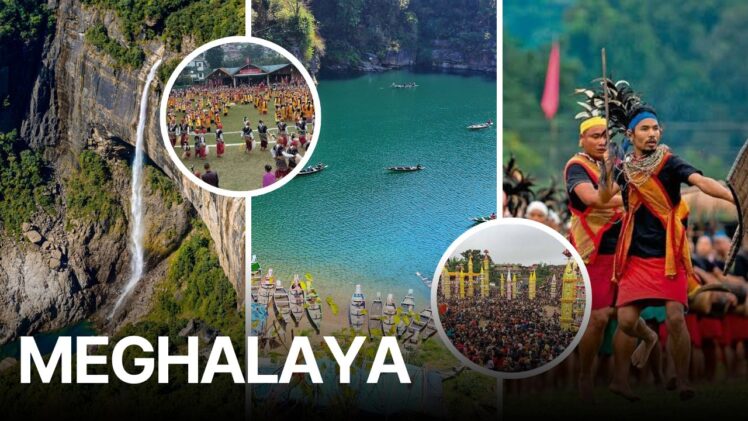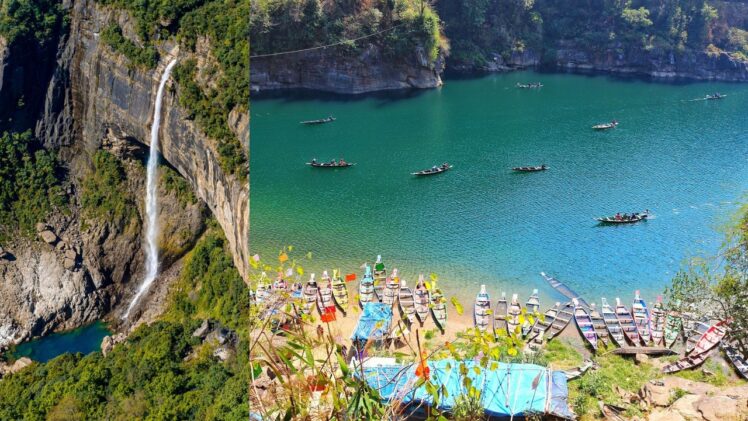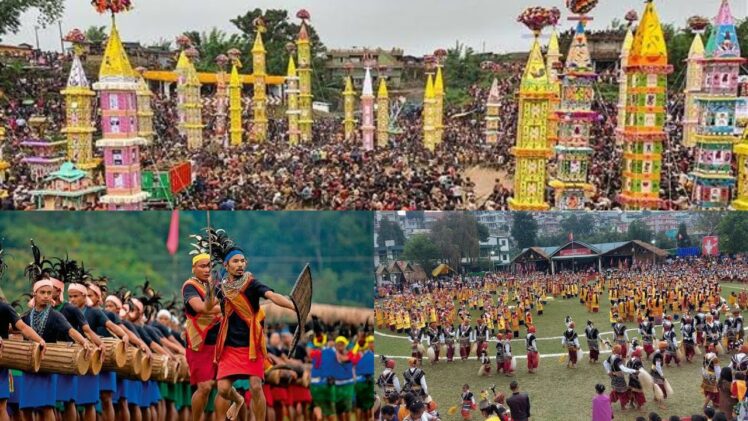
Tucked away in the lush hills of Northeast India lies Meghalaya, a land whose name means “Abode of Clouds”. Known for its spellbinding natural beauty, matrilineal system of inheritance, and ancient traditions, Meghalaya is one of India’s most unique and culturally rich states.
From its rain-drenched cliffs to its sacred forests and vibrant communities, Meghalaya offers a window into a world where nature and people live in close, respectful harmony.
A Land of Hills, Rain, and Rivers
Geographically, Meghalaya is nestled between Assam to the north and Bangladesh to the south. It is home to three major hill regions: the Khasi Hills, the Jaintia Hills, and the Garo Hills—each corresponding to one of the state’s three main tribal communities.
Two of the wettest places on Earth, Sohra (Cherrapunjee) and Mawsynram, are found in this region. These villages receive over 11,000 mm of rainfall annually, thanks to Meghalaya’s location in the path of moisture-heavy monsoon winds. The result? Verdant landscapes, dramatic waterfalls like Nohkalikai Falls, and cloud-kissed mountain tops that look straight out of a dream.

A Matrilineal Society
What sets Meghalaya apart culturally is its matrilineal system, among all the major tribes — the Khasi, Jaintia and Garo. In this system, inheritance, family lineage, and clan identity pass through the mother’s line. The youngest daughter traditionally becomes the custodian of the family property and takes care of aging parents. Women enjoy strong social status, and this cultural framework challenges many conventional assumptions about gender roles in South Asia.
However, this doesn’t mean the society is matriarchal—political power often still rests with men, but the centrality of women in family and social life is deeply embedded and revered.
ALSO WATCH:
Languages and Ethnic Diversity
English is the official language of the state, but it’s just one among many. Indigenous languages like Khasi, Garo, and Pnar (spoken by the Jaintias) are widely spoken and preserved through oral traditions, songs, and stories. Meghalaya is a state where language is not only a medium of communication but a vessel of identity.
The people of Meghalaya are primarily from Tibeto-Burman (Garo) and Austroasiatic (Khasi-Jaintia) ethnic roots, and their warm hospitality and gentle demeanor are often noted by visitors.
Sacred Forests, Living Bridges, and Biodiversity
Nature in Meghalaya isn’t just beautiful—it’s sacred. The Sacred Groves, like the famous Mawphlang Sacred Forest, are preserved – They are patches of ancient forest that are protected by indigenous religious beliefs. Locals believe these forests are inhabited by spirits and ancestors, and no plants or animals may be harmed inside.
One of Meghalaya’s most astonishing eco-architectural marvels are the Living Root Bridges—handmade bridges crafted over decades by training the aerial roots of rubber fig trees (Ficus elastica) across streams and rivers. These bridges can last hundreds of years and are still used today. The double-decker bridge in Nongriat is a major attraction for both trekkers and researchers alike. Truly, an indigenous ingenuity.
The state is also home to Asia’s longest cave systems, like Liat Prah, Siju, and Mawsmai, making Meghalaya a hotspot for speleologists (cave scientists).
Spirituality and Festivals
While Christianity is the predominant religion—introduced by Welsh and German missionaries during the colonial era—traditional beliefs still thrive in certain pockets of the state. Many communities maintain strong connection to nature spirits and ancestral worship.

Festivals are deeply rooted in the land and seasonal cycles. Some prominent ones include:
Shad Suk Mynsiem – A Khasi thanksgiving dance festival.
Behdeinkhlam – Celebrated by the Jaintias, involving rituals to drive away plague and disease.
Wangala – The Garo post-harvest festival honoring the Sun God and featuring rhythmic drumming and dancing.
ALSO WATCH:
Education and Urban Charm
The capital city Shillong, often called the “Scotland of the East”, is known for its sublime weather, its rich historical heritage, colonial architecture, and music scene. It was once known as the “Hub of Education” in Northeast India. It is home to institutions like the North-Eastern Hill University (NEHU), IIM Shillong, and several century-old mission-run schools and colleges that attract students from across the region.
Meghalaya has a literacy rate above the national average. As of 2024, Meghalaya achieved a literacy rate of 94.2%, ranking 5th in the list of literate states/UTs in the country, after Kerala.
Meghalaya’s economy is largely agrarian, with major crops including rice, maize, potatoes, and citrus fruits like oranges and pineapples. The state is also known for organic farming practices, as well as its handicrafts made of bamboo and cane.
World’s famous Lakadong turmeric is also produced in Meghalaya, predominantly in the Jaintia Hills region. The state is also known for its sericulture sector – the most common being the Ryndia.
However, the state also faces challenges—unregulated coal and limestone mining have led to environmental degradation in some areas, raising concerns about balancing development with sustainability.
ALSO WATCH:
Meghalaya in the gamut of Ecological wonders
Meghalaya is permanently inscribed in the history of geology through the Meghalayan Age, which highlights the region’s crucial contribution to Earth’s timeline. ‘The Meghalayan Age’, the onset of which about 4,200 years ago was marked by a mega-drought that crushed a number of civilisations worldwide.
The evidence for the same was first recorded in the Mawmluh cave located in Sohra (Cherrapunjee) in Meghalaya.
A Young Yet Proud State
Meghalaya became a full-fledged state of India on January 21, 1972, carved out of Assam. Despite being relatively young as a political entity, it holds a profound and ancient cultural heritage. It contributes representatives to the Indian Parliament and has its own Legislative Assembly.
Today, Meghalaya stands as a vibrant symbol of tribal resilience, ecological wisdom, and cultural pride—offering a model of how communities can preserve their identity while engaging with the modern world.
Meghalaya is more than just a place—it’s a philosophy in motion. Its harmony with nature, reverence for tradition, and celebration of women in society make it one of India’s most enchanting and enlightening states. Whether you’re a traveler, a student, or a cultural enthusiast, Meghalaya has something to teach and something to cherish.






